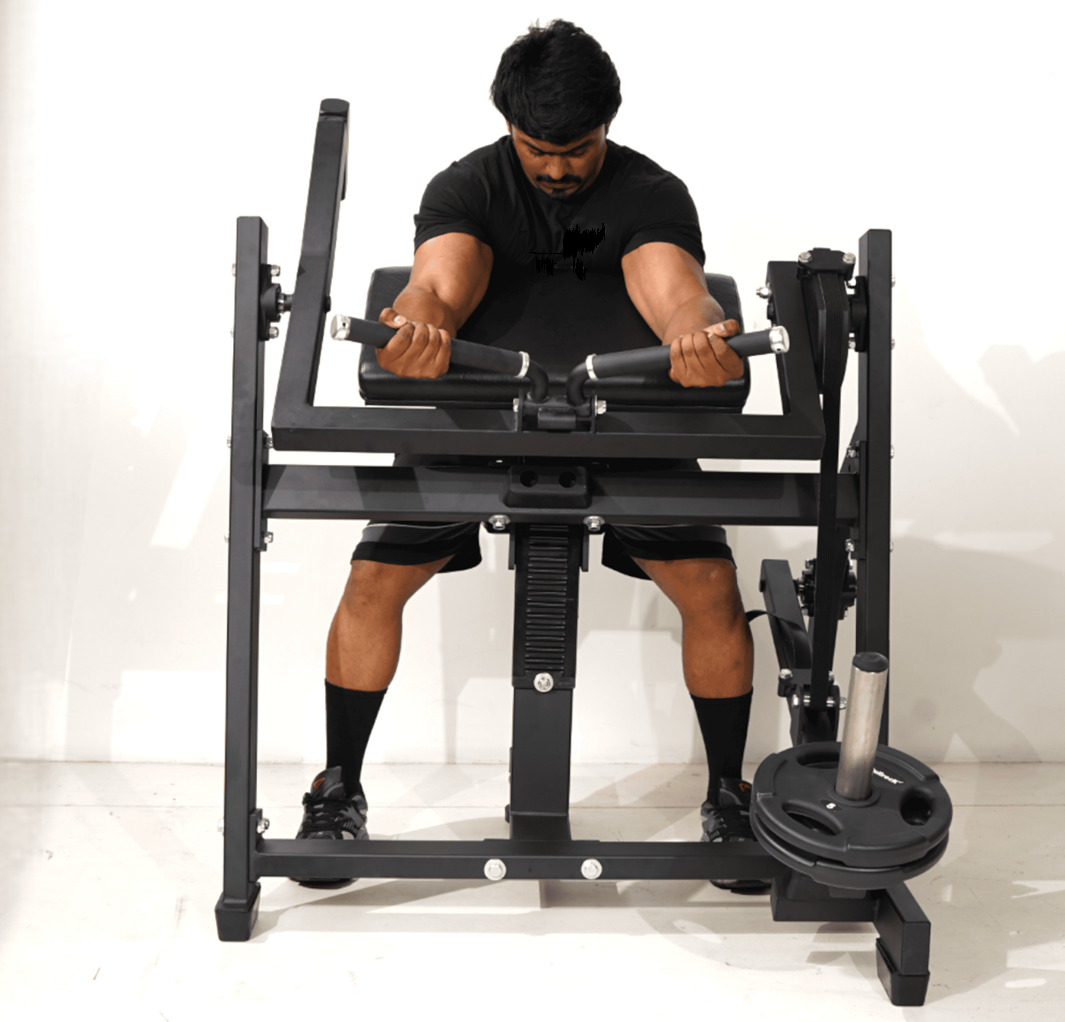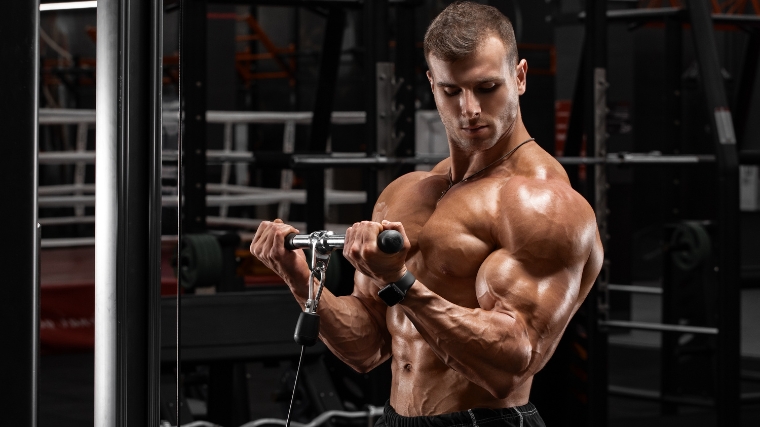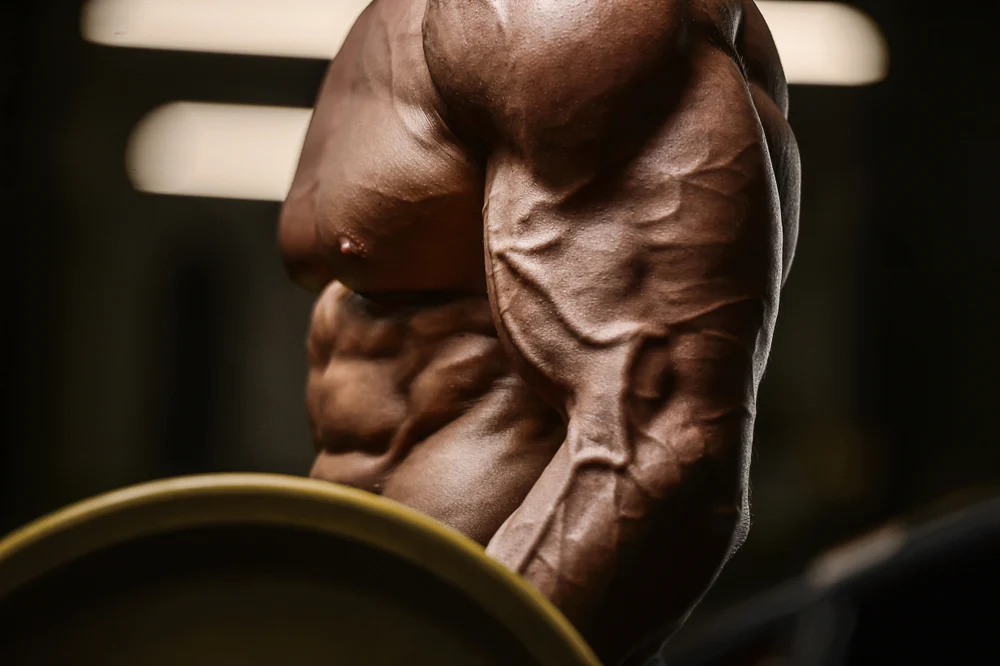Machine Bicep Curl: Precision Hypertrophy Through Stability and Control
In the world of biceps training, the Machine Bicep Curl often gets overshadowed by its free-weight counterparts — the barbell curl, dumbbell curl, and preacher curl.
Yet, for bodybuilders who’ve been around long enough to understand muscle mechanics and training efficiency, machine curls represent something essential: tension without distraction.
The beauty of the machine bicep curl lies in its simplicity. No balance required. No coordination issues. Just pure, consistent tension directly on the biceps from the start to finish of every rep.
It removes all the “noise” and lets you zero in on contraction, control, and overload — exactly what hypertrophy demands.
In modern bodybuilding programming, machine curls serve as both a mass builder and finisher, offering unmatched stability for squeezing every ounce of growth out of fatigued arms.
Whether you’re a beginner learning proper curl mechanics or an advanced athlete refining biceps detail, the machine curl deserves a permanent slot in your arm arsenal.
Muscles Worked
- Primary Muscle:
- Biceps brachii (long and short heads).
- Secondary Muscles:
- Brachialis — underlying muscle that adds mid-arm thickness.
- Brachioradialis — assists in elbow flexion, adds upper forearm density.
- Forearm flexors — stabilize the wrist throughout the curl.
👉 Depending on the machine design (preacher pad vs seated vertical arm curl), you can subtly shift emphasis toward the short head (inner arm) or long head (outer arm and peak).
Benefits of the Machine Bicep Curl
- Constant Tension Through Full Range
- Machines maintain consistent load across the entire motion, stimulating muscle fibers evenly.
- Eliminates Momentum
- The guided path prevents body swing or cheating — all effort stays focused on the biceps.
- Superior Isolation
- Stabilization is built into the machine, letting you target the biceps without secondary muscle fatigue.
- Joint-Friendly Mechanics
- Smooth cam and ergonomic handles reduce wrist and elbow strain.
- Ideal for Drop Sets and Volume Work
- Weight stacks allow for fast load adjustments — perfect for intensity techniques.
- Great for Beginners and Pros Alike
- Easy to learn, hard to mess up, and scalable for all strength levels.
Types of Machine Bicep Curls
- Seated Arm Curl Machine (Vertical Curl Machine)
- You sit upright, arms at your sides curling upward — mimics a standing dumbbell curl with guided motion.
- Preacher Curl Machine
- Upper arms rest on a preacher pad; isolates the biceps with deep stretch and controlled contraction.
- Plate-Loaded Machine Curl
- Resistance provided by plates — often features a more natural strength curve.
- Selectorized Stack Machine Curl
- Uses a pin-loaded weight stack — convenient for quick load changes and drop sets.
- One-Arm Machine Curl
- Allows unilateral training for symmetry and focus.
How to Perform the Seated Machine Bicep Curl (Step-by-Step)
Setup
- Adjust the seat height so your elbows line up with the machine’s pivot point.
- Sit down with your chest upright and back flat against the pad.
- Grip the handles with an underhand (supinated) grip.
- Keep your elbows tucked tightly to your sides.
Execution
- Start with arms fully extended — feel a light stretch in the biceps.
- Curl the handles upward by contracting your biceps.
- Keep your upper arms stationary — only forearms should move.
- Squeeze your biceps hard at the top for 1–2 seconds.
- Slowly lower back to the starting position under control.
Breathing
- Exhale during the curl.
- Inhale as you lower back down.
Tempo
- Concentric (lift): 1–2 seconds.
- Peak contraction: 1 second.
- Eccentric (lower): 3 seconds.
How to Perform the Preacher Machine Curl
- Adjust the preacher pad so your upper arms rest comfortably against it.
- Grip the handles shoulder-width apart with palms facing up.
- Start with arms fully extended for a full stretch.
- Curl the handles toward your shoulders, keeping the upper arms flat on the pad.
- Squeeze at the top, then lower slowly until you feel the stretch again.
👉 The preacher pad locks your arms in place, completely isolating the biceps and preventing momentum.
Common Mistakes and Fixes
- Using Excessive Weight
- Mistake: Hunching shoulders or jerking the handles up.
- Fix: Use a weight that lets you control every phase of the lift.
- Partial Range of Motion
- Mistake: Only curling halfway.
- Fix: Fully extend and contract on every rep for maximum fiber recruitment.
- Letting the Weight Stack Rest
- Mistake: Losing tension at the bottom.
- Fix: Keep constant tension — stop just before the plates touch.
- Fast, Uncontrolled Eccentric
- Mistake: Dropping the weight down.
- Fix: Lower slowly — eccentric control is key for hypertrophy.
- Leaning Forward or Back
- Mistake: Shifting body to move the weight.
- Fix: Keep your torso still; isolate the arms.
Programming Guidelines
For Hypertrophy (Muscle Growth)
- Sets: 3–4
- Reps: 10–15
- Rest: 60–90 seconds
- Load: Moderate — enough to reach near failure without form breakdown.
For Strength & Density
- Sets: 3–5
- Reps: 6–8
- Rest: 90–120 seconds
- Load: Heavy, with slow controlled form.
For Finisher / Pump Work
- Sets: 2–3
- Reps: 15–20
- Rest: 45 seconds or less
- Technique: Use drop sets or rest-pause training for maximum pump.
How to Integrate into Your Training
Example Arm Day
- Barbell Curl: 4×8
- Incline Dumbbell Curl: 3×10–12
- Cable Curl: 3×12–15
- Machine Bicep Curl: 3×15 (finisher for pump and detail)
Example Push/Pull/Legs Split (Pull Day)
- Pull-Up: 4×10
- Barbell Row: 4×8
- Dumbbell Curl: 3×10
- Machine Bicep Curl: 3×12–15
👉 Machine curls fit best as the last or second-to-last exercise in your biceps routine, when your arms are pre-fatigued and stability aids precision.
Advanced Training Techniques
- Drop Sets
- Perform a set to failure, immediately reduce weight by 20–30%, and continue curling until failure again.
- Rest-Pause Training
- Do one set to failure, rest 15 seconds, then perform additional mini-sets until you can’t hit 3 reps.
- Tempo Manipulation
- Slow down the eccentric to 4–5 seconds for deeper fiber recruitment.
- Partial Reps at the Top
- After reaching failure, perform short-range “burnout” reps at the top for added pump.
- Isometric Hold Sets
- Hold the contraction at mid-range for 10 seconds between reps to intensify tension.
Machine Bicep Curl vs. Free Weights
| Factor | Machine Curl | Free-Weight Curl |
| Tension Curve | Constant throughout | Stronger at midrange, weaker at top |
| Stabilization | Built-in (machine provides stability) | Requires active stabilization |
| Form Control | High – guided movement | Depends on technique and core control |
| Joint Stress | Low | Moderate (more elbow/wrist strain potential) |
| Hypertrophy Focus | High (isolation emphasis) | Moderate to high |
| Strength Carryover | Moderate | High |
👉 Use both. Free weights build raw size and strength; machines refine and polish.
Bodybuilder’s Tips
- Focus on Feel: Think about squeezing the biceps, not just moving the weight.
- Maintain Shoulder Position: Don’t let your shoulders roll forward — keep chest high.
- Slight Pause at the Top: A 1-second squeeze enhances contraction intensity.
- Experiment with Handles: Some machines allow neutral or angled grips — find what feels most natural.
- Stretch Between Sets: Extend your arms behind you to maintain elasticity and enhance recovery.
Practical Takeaways
- Machine bicep curls isolate the biceps completely, maximizing hypertrophy potential.
- Ideal for high-volume training and end-of-workout finishers.
- Promotes safety, joint comfort, and precision for long-term growth.
- Perfect for advanced intensity techniques like drop sets and rest-pause.
- Complements free-weight curls — don’t replace, combine.
Conclusion
The Machine Bicep Curl isn’t about ego or numbers — it’s about refinement, control, and precision.
It’s the exercise that allows you to focus purely on the squeeze, pushing blood into the biceps until the pump feels like your skin can barely contain it.
When used correctly, machine curls become one of the most efficient tools for maximizing biceps size, symmetry, and definition.
They let you finish your arm sessions strong — with intensity, isolation, and perfect form — the way true bodybuilding is meant to be trained.
So the next time you walk past the curl machine, don’t think of it as “beginner equipment.” Think of it as your finishing scalpel — the final touch that turns hard-earned muscle into masterpiece-level detail.




